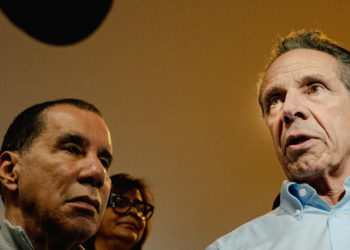When President Trump said he would enact sweeping tariffs and crack down on immigration, dire warnings rang out in the construction industry.
The policies threatened to push up building costs and deprive the industry of a crucial pool of labor when high interest rates were already depressing building activity.
Those forces are converging on builders, weighing them down in a potential drag on the economy. Higher import taxes on steel, copper, lumber and other materials are lifting construction prices and interrupting some jobs. Immigration enforcement is worsening worker shortages and delaying projects.
“We get so many things thrown at us in the construction industry,” said Tony Rader, the chief relationship officer at National Roofing Partners, a commercial roofing company in Coppell, Texas. “It just seems like every time we turn around, we’ve got something else to fight.”
The rising costs and understaffing could impede the momentum the industry is expected to derive from lower interest rates, economists say. The effects could be most pronounced in the housing industry, where elevated mortgage rates have discouraged homeowners from moving and dragged down sales.
Mr. Rader said tariffs on products from China had pushed up the cost of screws, plates and other supplies. Mr. Trump said on Thursday that he and China’s leader, Xi Jinping, had agreed to a one-year deal to reduce the overall tariff on many Chinese goods by 10 percentage points, to around 47 percent.
The possibility that immigration agents could target job sites has made some employees reluctant to come to work even though they are in the country legally, he said. He said one of his subcontractors had missed out on a roofing project near the U.S.-Mexican border this year because he could not field a crew of workers.
His clients are also worried about uncertain pricing and the possibility that staffing issues could affect construction jobs. Some have delayed putting on expensive new roofs, he said, and have asked instead for maintenance plans on existing ones. His revenue is shrinking, and he is looking for ways to cut spending. He is budgeting for slower growth next year.
Mr. Trump has imposed tariffs on a wide range of materials and foreign-made products that the construction industry needs. In addition to levies on steel and other metals, tariffs ranging from 10 to 50 percent on foreign timber, lumber and wood products like kitchen cabinets and bathroom vanities went into effect last month.
The tariffs are meant to encourage more domestic manufacturing. But so far, that has not been the case.
The complicated nature of supply chains means that it will take time for companies that buy materials from abroad to shift gears. It is also unclear whether foreign suppliers, American companies or consumers will shoulder the extra costs — and how much prices will rise for consumers.
Earlier this year, the National Association of Home Builders estimated that tariffs would inflate the cost of building a typical home by $10,900. Prices on construction materials have risen 2.3 percent from a year earlier, according to data from the Bureau of Labor Statistics. Iron and steel prices are up 9.2 percent year over year, and copper wire and cable have increased 13.8 percent.
Justin Wood, an owner of Fish Construction NW, which builds starter homes in Portland, Ore., said tariffs on lumber, drywall and heating equipment had pushed up his construction costs $2,500 to $3,000 a home.
The increase has been manageable, he said, because the homes he builds are meant to be small and affordable — they are usually between 1,000 and 1,200 square feet and cost about $250,000 to build.
Mr. Wood said he was concerned about the price of lumber from Canada, which is subject to a combined tariff rate of up to 45 percent. A lumberyard that he uses is looking into acquiring more American lumber, he said, but may not succeed.
“If they’re not able to source what we need locally, then they may have to buy it from Canada, and that may ultimately be a price increase from the lumber side of things,” he said.
Mr. Trump’s immigration policy is also taking a toll.
Construction this year added just 6,000 jobs through August. One analysis found that the industry would require nearly half a million more workers this year to meet projected demand.
At the same time, the industry’s unemployment rate fell to 3.2 percent, equaling its record low. Those two data points suggest that the supply of available workers has decreased.
“The current immigration policies are putting huge stress on the work force,” said Michael Bellaman, the chief executive and president of Associated Builders and Contractors, a trade group that endorsed Mr. Trump last year. “There’s no doubt that that is problematic.”
A survey conducted in July and August by another trade group, the Associated General Contractors of America, found that more than a quarter of respondents had been affected by Mr. Trump’s immigration enforcement actions.
The Pew Research Center has estimated that undocumented workers made up 13 percent of the construction industry in 2022. Companies are supposed to verify that their direct employees are in the country legally, but they often outsource work such as roofing, tiling and painting to subcontractors that make their own hiring decisions.
Andrew Kaye, a luxury homebuilder in Milltown, N.J., said the presence of immigration agents in Newark seemed to scare away some workers for a few days. “There was a ripple effect,” he said.
Immigration agents also recently targeted a home in the Chicago area where construction workers were replacing windows and siding. The raid sent a chill through the neighborhood, said Leo Feler, an economist and the home’s owner.
“This construction project is now stopped,” he said. “I think construction in this entire neighborhood is now stopped because everyone is so fearful.”
The effects of the administration’s policies may become more visible in the months ahead. Many of the most punishing tariffs have been in place only since August, so they have not had time to work their way through the economy. Exporters and suppliers may also be hesitant to pass on price increases if they think the United States will negotiate trade deals or the tariffs will be struck down in court.
Elevated rates, and the resulting pullback in demand for construction, could be reducing the squeeze of higher costs and fewer workers.
Construction spending has been fading since spring 2024, even with a rush of spending on data centers. New home construction in August fell 6 percent from a year earlier and is well below its pandemic-era peak.
If interest rates continue to fall, suppliers will have more leverage to pass on costs to customers. With immigration enforcement depleting the supply of available immigrant workers, companies racing to staff projects would find themselves in steeper competition for employees, driving up wages.
“We’ve already seen some challenges, both in terms of the cost of materials being driven higher and now the labor shortages being exacerbated by deportation policies,” said Selma Hepp, the chief economist at Cotality, a real estate data provider.
But she added, “I think we haven’t seen the worst of it yet.”
Steve Martinez, the president of Tradewinds General Contracting, a homebuilder in Boise, Idaho, has been tacking a larger contingency cost onto budgets for clients to mitigate potential tariff-related price increases.
For now, his expenses have not gone up as much as he predicted, which he largely attributed to the slow pace of new home construction. He said he expected to build just seven of the high-end custom homes that are his firm’s specialty this year, down from 10 to 12 usually.
“The demand is not there, and so we haven’t quite seen the price escalation that we all envisioned or assumed we would see overnight,” Mr. Martinez said.
He hopes lower interest rates will reverse the housing industry’s slide. But he also worries that stronger demand will end up amplifying the impact of the administration’s policies.
“Had we been really busy, I think we would have felt it a lot quicker,” he said.
Ben Casselman contributed reporting.
Sydney Ember is a Times business reporter, covering the U.S. economy and the labor market.
The post Builders Find Hardship in Trump’s Tariffs and Deportations appeared first on New York Times.




